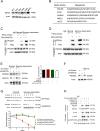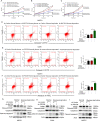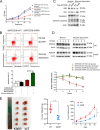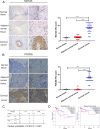MAT2A facilitates PDCD6 methylation and promotes cell growth under glucose deprivation in cervical cancer
- PMID: 35396512
- PMCID: PMC8993843
- DOI: 10.1038/s41420-022-00987-6
MAT2A facilitates PDCD6 methylation and promotes cell growth under glucose deprivation in cervical cancer
Abstract
The underlying mechanisms of methionine adenosyltransferase 2 A (MAT2A)-mediated cervical cancer progression under nutrient stress are largely elusive. Therefore, our study aims to investigate molecular mechanism by which MAT2A-indcued cervical oncogenesis. The interaction between MAT2A and programmed cell death protein 6 (PDCD6) in cervical cancer cell lines was detected by immunoprecipitation, immunoblotting and mass spectrometric analysis. A panel of inhibitors that are linked to stress responsive kinases were utilized to detect related pathways by immunoblotting. Cell proliferation and apoptosis were investigated by CCK-8 and flow cytometry. Apoptosis related protein level of Bcl-2, Bax and Caspase-3 was also analyzed in cells with PDCD6 K90 methylation mutation. The association between MAT2A and PDCD6 was detected by immunohistochemistry and clinicopathological characteristics were further analyzed. We found that the interaction between MAT2A and PDCD6 is mediated by AMPK activation and facilitates PDCD6 K90 methylation and further promotes protein stability of PDCD6. Physiologically, expression of PDCD6 K90R leads to increased apoptosis and thus suppresses growth of cervical cancer cells under glucose deprivation. Furthermore, the clinical analysis indicates that the MAT2A protein level is positively associated with the PDCD6 level, and the high level of PDCD6 significantly correlates with poor prognosis and advanced stages of cervical cancer patients. We conclude that MAT2A facilitates PDCD6 methylation to promote cervical cancer growth under glucose deprivation, suggesting the regulatory role of MAT2A in cellular response to nutrient stress and cervical cancer progression.
© 2022. The Author(s).
Conflict of interest statement
The authors declare no competing interests.
Figures






Similar articles
-
PDCD6 cooperates with C-Raf to facilitate colorectal cancer progression via Raf/MEK/ERK activation.J Exp Clin Cancer Res. 2020 Aug 3;39(1):147. doi: 10.1186/s13046-020-01632-9. J Exp Clin Cancer Res. 2020. PMID: 32746883 Free PMC article.
-
Programmed cell death 6 (PDCD6) as a prognostic marker for gastric cancers.Tumour Biol. 2012 Apr;33(2):485-94. doi: 10.1007/s13277-011-0280-4. Epub 2011 Dec 13. Tumour Biol. 2012. PMID: 22161137
-
PDCD6 additively cooperates with anti-cancer drugs through activation of NF-κB pathways.Cell Signal. 2012 Mar;24(3):726-33. doi: 10.1016/j.cellsig.2011.11.006. Epub 2011 Nov 12. Cell Signal. 2012. PMID: 22142513
-
Pleiotropic effects of methionine adenosyltransferases deregulation as determinants of liver cancer progression and prognosis.J Hepatol. 2013 Oct;59(4):830-41. doi: 10.1016/j.jhep.2013.04.031. Epub 2013 May 7. J Hepatol. 2013. PMID: 23665184 Review.
-
Methionine adenosyltransferases in cancers: Mechanisms of dysregulation and implications for therapy.Exp Biol Med (Maywood). 2018 Jan;243(2):107-117. doi: 10.1177/1535370217740860. Epub 2017 Nov 15. Exp Biol Med (Maywood). 2018. PMID: 29141455 Free PMC article. Review.
Cited by
-
Modulation of m6A RNA modification by DAP3 in cancer cells.Proc Natl Acad Sci U S A. 2024 Oct;121(40):e2404509121. doi: 10.1073/pnas.2404509121. Epub 2024 Sep 24. Proc Natl Acad Sci U S A. 2024. PMID: 39316047 Free PMC article.
-
Nosip is a potential therapeutic target in hepatocellular carcinoma cells.iScience. 2023 Jul 10;26(8):107353. doi: 10.1016/j.isci.2023.107353. eCollection 2023 Aug 18. iScience. 2023. PMID: 37529099 Free PMC article.
-
RBM15-mediated the m6A modification of MAT2A promotes osteosarcoma cell proliferation, metastasis and suppresses ferroptosis.Mol Cell Biochem. 2025 May;480(5):2923-2933. doi: 10.1007/s11010-024-05149-z. Epub 2024 Nov 11. Mol Cell Biochem. 2025. PMID: 39527319
-
What is the role of circRNAs in the pathogenesis of cervical cancer? A systematic literature review.Front Genet. 2024 May 27;15:1287869. doi: 10.3389/fgene.2024.1287869. eCollection 2024. Front Genet. 2024. PMID: 38859935 Free PMC article.
-
The Contribution of PDCD6 Polymorphisms to Oral Cancer Risk.Cancer Genomics Proteomics. 2022 Jul-Aug;19(4):456-463. doi: 10.21873/cgp.20332. Cancer Genomics Proteomics. 2022. PMID: 35732318 Free PMC article.
References
LinkOut - more resources
Full Text Sources
Molecular Biology Databases
Research Materials
Miscellaneous

